Abstract
The conflict between exploitation of coal resources and environmental protection is highly pronounced in the Wanli mining area, located in the arid and semi-arid region of Inner Mongolia, China. The impact of mining operations has led to varying degrees of surface subsidence, which further threatens the ecological environment as coal extraction continues. The Small Baseline Subset Interferometric Synthetic Aperture Radar (SBAS-InSAR) technique offers significant advantages over traditional subsidence monitoring methods, particularly in complex terrain with vertical and horizontal valleys. This approach enables large-scale, low-cost, and all-weather monitoring. Based on 64 Sentinel-1A SAR images from 2018 to 2023, this study aims to promptly identify the location, deformation degree, and evolution characteristics of mining-induced subsidence within the study area using SBAS-InSAR techniques. The results indicate that the area affected by mining-induced subsidence covers 109.73 km2, with a maximum cumulative subsidence of 283.41 mm and a maximum subsidence velocity of 46.45 mm/y. Additionally, during the field verification, 29 ground fractures, predominantly located along the precipitous borders of subsidence areas, were identified, validating the credibility of the monitoring results. This study demonstrates that SBAS-InSAR technology remains highly effective in the erosional terrain of the Loess Plateau. The monitoring data can help in-production mining to accurately identify the characteristics and patterns of surface subsidence induced by coal mining operations. It provides reliable policymaking data support and makes significant contributions to optimize cost-efficiency and guide targeted monitoring efforts in subsequent management work of the Wanli mining area as well as other mining areas.
1. Introduction
Coal resources constitute a significant portion of Chinese energy consumption mix [1], with reserves accounting for 91.2% of the country’s major energy mineral reserves, according to a report from Ministry of Natural Resources of the People’s Republic of China in 2023. Large-scale coal mining operations have led to progressive expending and deepening of goaf areas. The overburden strata above goaf areas experience gravitational collapse and fracturing, with deformation migrating upward through the rock mass until manifesting as surface subsidence [2]. Ground fractures frequently develop at the edges of subsidence zones, where vegetation root systems are damaged due to surface tension or compression, leading to subsequent vegetation degradation [3,4]. Consequently, proactive subsidence monitoring represents a critical mitigation measure against potential geohazards while simultaneously safeguarding the ecological environment [5,6].
However, traditional surface subsidence monitoring methods, such as leveling, electronic total station, and Global Navigation Satellite System (GNSS), face significant challenges in meeting the demands of large-scale mining monitoring due to their high costs, sparse observation coverage, and labor intensity [7,8]. In contrast, Interferometric Synthetic Aperture Radar (InSAR) technology has emerged as a more advanced and effective approach for monitoring surface subsidence, with advantages relating to its wide range, low cost, and all-weather usability, which led to its rapid development and widespread adoption. Differential InSAR (D-InSAR), an extension of conventional InSAR technology [9,10,11], has been proven effective worldwide in measuring surface deformation and predicting mine-related seismic activity [12]. However, it still faces challenges such as poor temporal consistency and ineffectiveness for large-scale deformation monitoring [13,14,15]. The development of time series InSAR techniques [16], particularly SBAS-InSAR and persistent scatterer InSAR (PS-InSAR) [17,18,19], have effectively addressed the poor temporal resolution and coherence loss of D-InSAR. Both SBAS-InSAR and PS-InSAR have the advantage of anti-interference and high precision [20], while PS-InSAR imposes stringent stability requirements on monitoring targets. In comparison, SBAS-InSAR proves more suitable for monitoring surface subsidence in mining areas characterized by limited persistent scatterers [21,22,23,24,25].
Ordos, a main prefecture-level city in the Inner Mongolia Autonomous Region, is one of the most important clusters of the modern coal chemical industry cluster in China. Ordos possesses substantial coal resources, with its reserves occupying about one-sixth of China’s total coal reserves, which is estimated at more than one trillion tons. However, the region is facing severe ecological degradation and frequent geological disasters, which are exacerbated by coal mining operations [26,27,28,29,30]. Due to the erosional terrain of the Loess Plateau, traditional surface subsidence monitoring methods struggle to capture the extensive mine-induced subsidence in Ordos, which results in an incomplete and imprecise assessment of surface subsidence within the mining areas.
Consequently, this study utilizes SBAS-InSAR techniques [31], along with European radar imaging satellite (Sentinel-1A) data from 2018 to 2023, to monitor surface subsidence in the Wanli mining area, which is a major coal mining area in Ordos. The study aims to investigate the characteristics and patterns of coal mining-induced subsidence in the erosional landforms of the Loess Plateau. The findings are intended to provide valuable reference data for analyzing surface subsidence patterns across diverse geological settings. In addition, this study provides reliable policymaking data to optimize cost efficiency and guide targeted monitoring in subsequent management work. Moreover, it offers methodological references for mining regions with similar geomorphological conditions.
2. Materials
2.1. Study Area
The Wanli mining area, situated in the northeastern part of Ordos (Figure 1), is one of the main coal mining areas in Ordos. It is located in the transitional zone between the Loess Plateau and the Mongolia-Ordos Plateau [32], where the surface features a heavily dissected landscape with extensive erosional landforms. The climate of the study area is arid and semi-arid, with widespread desertification affecting much of the mining field.
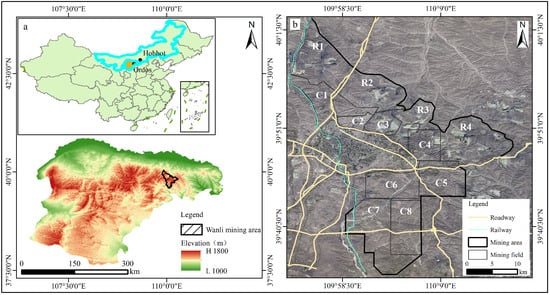
Figure 1.
Geographical location of the Wanli mining area in Ordos (Inner Mongolia, China). (a) Digital Elevation Model of Ordos; (b) Landsat 9 image of the Wanli mining area on 6 December 2023.
The Wanli mining area, a critical component of China’s strategic coal reserves, plays a vital role in ensuring the stability of the national coal market by supplying coal to deficit regions such as East and Central China. The area comprises eight mine fields and four integrated reconstruction zones, covering a total area of about 700 km2. The region has an irregular shape, extending 24 km to 50 km from north to south and 6 km to 42 km from east to west, as detailed in Table 1.

Table 1.
Detailed information of the twelve zones studied in the Wanli mining area.
2.2. Data
With the purpose of meticulously monitoring mining-induced surface subsidence in the study area, this paper uses Sentinel-1A data to derive information related to phase deformation in the Wanli mining area and employs the assistance of Precise Orbit Determination (POD) ephemeris data and the Shuttle Radar Topography Mission Digital Elevation Model (SRTM DEM) to eliminate orbit deviation and remove the interferometric terrain phase, respectively.
In this study, we collected Sentinel-1A data from the Alaska Satellite Facility (ASF) [33] by setting several specific search filters in order to capture, in interferometric wide (IW) swath mode, Sentinel-1A single look complex (SLC) images during its ascending orbit. Benefiting from a revisit cycle of 12 days, we selected 64 Sentinel-1A images in every month from 2018 to 2023, ensuring the precision and credibility of deformation results, which are detailed in Table 2.

Table 2.
Detailed parameters of Sentinel-1A data used in this study.
3. Methods
SBAS-InSAR is a technique that harnesses continuous multiple SAR images to perform time series analysis processing. By setting particular thresholds with respect to the time baseline and space baseline [34], it divides time series SAR images into several independent interference subsets, which ensures the coherence of interference pairs and further capture monitoring results of surface subsidence. Compared to D-InSAR, SBAS-InSAR involves more complex and time-consuming data processing. However, it is better suited for large-scale deformation monitoring and delivers superior time series resolution. Unlike PS-InSAR, SBAS-InSAR does not require highly stable monitoring targets, making it particularly effective for monitoring surface subsidence in mining areas on the eroded Loess Plateau, where few stable structures exist. Nevertheless, the SBAS-InSAR technique faces potential challenges, such as decorrelation in areas of rapid deformation or dense vegetation cover. In this study, the impact of vegetation cover on results is minimal, because the study area has sparse surface vegetation and is characterized by an arid to semi-arid climate. Still, abrupt subsidence in the central subsidence area leads to decorrelation in SBAS-InSAR results. Critically, SBAS-InSAR remains highly effective in detecting subtle deformations along subsidence margins, with validated measurement accuracy. This capability enables precise delineation of subsidence boundaries, providing mining operators with actionable data to strategically deploy conventional ground-based monitoring, which can reduce survey costs while maintaining observational rigor.
3.1. Principle of SBAS-InSAR
Among N time series (t1, t2, … tN) SAR images, a SAR image is supposed to be chosen as the super master image automatically, and the remaining N-1 SAR images are aligned with the super master image as slave images. Consequently, after the differential interference processing of each image pair, the differential interference phase of random pixel x in the interferogram [35] created by any two SAR images at moment tA and tB relative to super master image (tM) can be expressed as follows (Equation (1)):
where and are the phases of pixel x at moment tA and tB; is the wavelength of the radar signal; and are the relative accumulative deformations in the direction of the line of sight of pixel x at moment tA and tB; and , , , and are the topographic phase error, atmospheric phase error, orbit phase error, and noise phase error, respectively.
After eliminating diverse phase errors, accumulative deformation in the time interval between tA and tB can be seen as the product of average phase deformation velocity and the time interval under the assumption of linear deformation; thus, average phase deformation velocity can be formulated as follows (Equation (2)):
Through formulation of the above-mentioned equations for the differential interference phase of pixel x on every interference image pair, we can obtain the matrix form [36] as follows (Equation (3)):
The average phase deformation velocity of pixel x at an N-1 time interval can be solved by singular value decomposition (SVD) from the matrix equation (Equation (3)). Consequently, the time series of relatively cumulative deformations can be obtained further by integrating average phase deformation velocity at each time interval.
3.2. Data Processing
Used as an authoritative time series InSAR processing approach [37], SBAS-InSAR possesses the capabilities of yielding a high-quality differential interferogram based on flexible combinations of a certain amount of SAR images covering the study area and overcoming decoherence by setting appropriate thresholds, achieving further precise surface subsidence monitoring results. The detailed flowcharts of the SBAS-InSAR technique are shown in Figure 2.
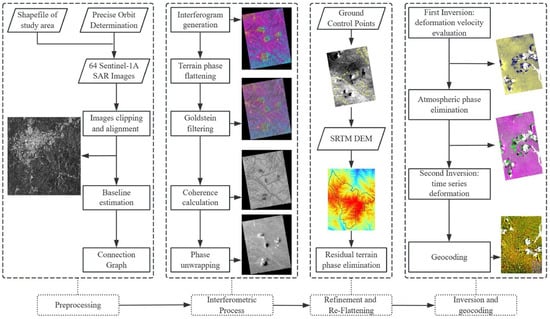
Figure 2.
Flowchart of the SBAS-InSAR technique (formally adapted from [34]).
Descriptions of several key steps with respect to data processing are as follows:
- (1)
- Preprocessing: The entire data processing workflow was performed using the SBAS-InSAR module in SARscape (version 5.2.1), developed by sarmap SA in Cascina, Switzerland. After configuring the initial environmental parameters, all SAR images were preprocessed (including cropping and registration) to prepare for the SBAS-InSAR analysis. Note that the polarization mode was set to the “VV” option due to its superior resistance to interference.
- (2)
- Connection graph: As the first step of SBAS-InSAR processing, 64 SAR images are supposed to be divided into a number of interference image pairs according to the thresholds of the time and space baselines. Specifically, the more image pairs there are, the more reliable the deformation results become, and the longer the data processing takes accordingly. In this study, we set the threshold of space baseline to 45% of the max space baseline and the threshold of time baseline to 120 days. Eventually, a SAR image from 26 February 2019 was selected as the super master image and 605 interference image pairs were acquired in total (Figure 3).
- (3)
- Interferometric process: In this stage, the above-mentioned interference image pairs were all subjected to an array of interference processing. Initially, all interference image pairs were aligned with the super master image. Afterwards, the SRTM DEM covering the study area was imported as assistance data, accomplishing the steps of interferogram generation, terrain phase flattening, Goldstein filtering, coherence calculation, and Minimum Cost Flow (MCF) phase unwrapping, in consecutive order [38].
- (4)
- Refinement and re-flattening: According to the Ground Control Points (GCPs) and Precise Orbit Determination (POD) ephemeris data, this step aims to estimate and eliminate the residual terrain phase and phase ramp after unwrapping. Crucially, at least 20 GCPs distributed uniformly in the study area were supposed to be selected at zones with few deformations [39].
- (5)
- Inversion: There are two steps to SBAS-InSAR inversion [40]. In the first step, deformation velocity and residual terrain phase were evaluated, which is the core of inversion. On the basis of deformation velocities, time series deformation results were captured, having experienced the estimation and elimination of the atmospheric phase by the Goldstein filtering method in the second step.
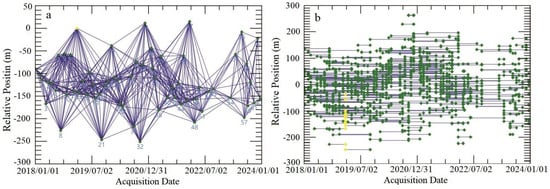
Figure 3.
Connection graph. (a) Time-position plot; (b) time-baseline plot (the yellow dots represent the super master image, the green dots represent slave images, and the line segments connecting the dots represent an interference image pair).
4. Results
In the course of SBAS-InSAR data processing, 64 Sentinel-1A SAR images covering the study area were used to monitor mining-induced surface subsidence in the Wanli mining area. This analysis provided detailed insights into the deformation along the satellite’s line of sight (LOS), including the locations of subsidence areas, the annual average deformation velocity, and the time series of subsidence events.
4.1. Spatial Distribution Characteristics of Surface Deformation
The relatively cumulative subsidence on 18 December 2023 is illustrated in Figure 4, where areas colored in blue, red, and green hues visually represent zones of subsidence, uplift, and stability, respectively. As shown in Figure 4, the distribution of mining-induced surface subsidence is clearly visible, with subsidence and uplift occurring simultaneously in 12 zones. The deformation values range from −283 mm to 150 mm, with negative values indicating surface subsidence and positive values representing land uplift. Further details, including the area of subsidence, maximum cumulative subsidence, and average cumulative subsidence in the 12 zones, are provided in Table 3. For instance, the largest area of mining-induced subsidence, spanning 17.75 km2, is found in zone R2, while the maximum cumulative subsidence of −283.41 mm occurs in zone C7, which also has the smallest subsidence area. Additionally, zone C5 experiences the highest average cumulative subsidence at −49.15 mm.
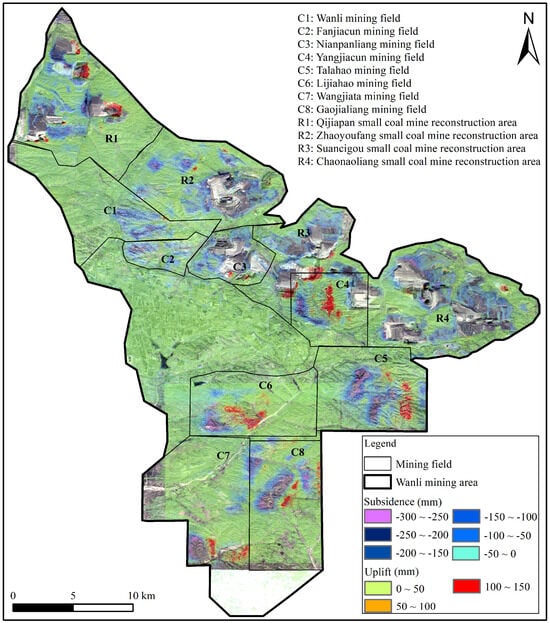
Figure 4.
Location of mining-induced surface subsidence in the Wanli mining area (the base map is a Landsat 9 image from 18 December 2023).

Table 3.
Details of cumulative subsidence in 12 zones on 18 December 2023.
4.2. Annual Average Velocity of Surface Deformation
The annual average deformation velocities of the study area from January 2018 to December 2023 are illustrated in Figure 5, with eight distinct hues representing velocity intervals ranging from −50 mm/y to 30 mm/y. Negative values indicate surface subsidence, while positive values denote land uplift, as previously mentioned. Overall, the lilac color, representing the fastest subsidence velocity interval of −50 mm/y to −40 mm/y, is predominantly observed in the southeastern mining fields of the study area. This suggests that surface subsidence velocities are more rapid in the southeast zones compared to the northwest. Detailed information, including the maximum and average subsidence velocities in the twelve zones, is provided in Table 4. Among the twelve zones, there are two zones that exhibit maximum subsidence velocities exceeding −40 mm/y, which are the southernmost mining field zone C7 (−46.45 mm/y) and the zone relating to the easternmost small coal mine reconstruction area R4 (−45.74 mm/y), respectively. There are three zones situated between C7 and R4, and two northernmost zones, where the maximum subsidence velocity surpasses −30 mm/y. These zones, listed from fastest to slowest, are C8 (−38.82 mm/y), R2 (−33.70 mm/y), R1 (−33.37 mm/y), C6 (−33.36 mm/y), and C5 (−30.49 mm/y). In contrast, the maximum subsidence velocity in the five zones between R4 and R1 is comparatively lower, with all exceeding −20 mm/y. These zones, in order of decreasing velocity, are R3 (−28.89 mm/y), C2 (−28.27 mm/y), C4 (−25.06 mm/y), C3 (−21.91 mm/y), and C1 (−20.97 mm/y). Additionally, we can also find that the average velocity of surface subsidence in zone C7 is the highest, indicating that mining-induced surface subsidence is most pronounced in this region. Across all subsidence zones, velocities gradually decrease from the subsidence center toward the margins. Such high annual average subsidence velocities are likely to have significant impacts on ecological environment protection and geological disaster prevention.
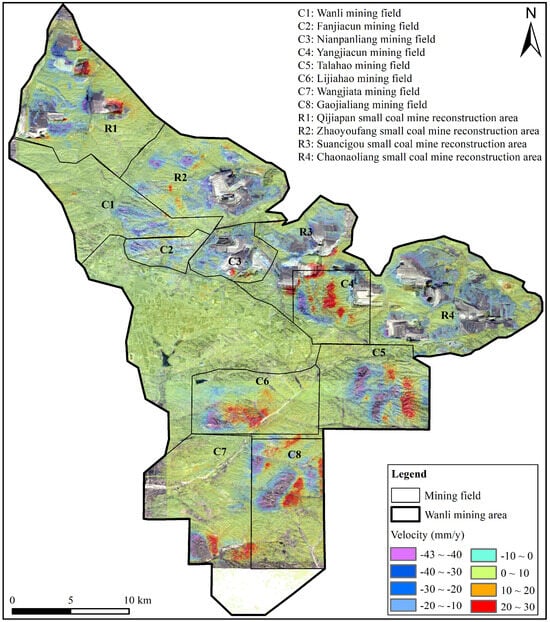
Figure 5.
Annual average velocity of surface deformation in the Wanli mining area.

Table 4.
Details of annual average subsidence velocities in 12 zones.
4.3. Time Series of Surface Deformation
Based on 64 diverse SAR images in the time series from 2018 to 2023, a series of cumulative surface deformation maps relative to the initial image from 6 January 2018 have been generated. To present more detailed and clear surface deformation results, 16 typical maps with approximately the same time interval of four months have been selected (Figure 6). As shown in the figure, mining-induced subsidence is evident in every zone across the eight mining fields and four small coal mine reconstruction areas. The subsidence areas exhibit a consistent pattern of expansion and intensification over time, which is visually confirmed by the progressively widening boundaries of blue tones representing surface subsidence and the deepening discoloration into blue or even lilac hues, indicating the worsening extent of subsidence as time progresses. A closer analysis reveals that subsidence in the southeastern zones of the study area is more severe compared to other zones. This is evidenced by the lilac areas, where subsidence exceeds −250 mm, appearing consistently in every southeastern zone, while these extreme subsidence levels are scarcely observed in the northwestern zones.
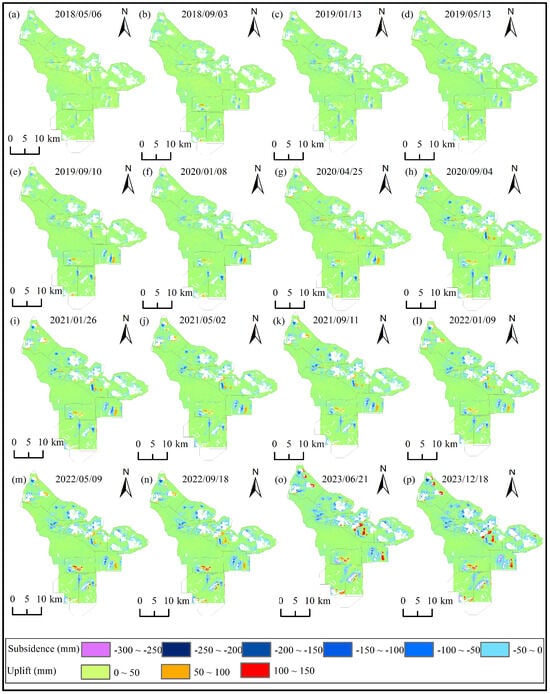
Figure 6.
Time series of mining-induced surface deformation from 2018 to 2023. (a) Surface subsidence on 6 May 2018; (b) Surface subsidence on 3 September 2018; (c) Surface subsidence on 13 January 2019; (d) Surface subsidence on 13 May 2019; (e) Surface subsidence on 10 September 2019; (f) Surface subsidence on 8 January 2020; (g) Surface subsidence on 25 April 2020; (h) Surface subsidence on 4 September 2020; (i) Surface subsidence on 26 January 2021; (j) Surface subsidence on 2 May 2021; (k) Surface subsidence on 11 September 2021; (l) Surface subsidence on 9 January 2022; (m) Surface subsidence on 9 May 2022; (n) Surface subsidence on 18 September 2022; (o) Surface subsidence on 21 June 2023; (p) Surface subsidence on 18 December 2023.
To further analyze the detailed surface subsidence conditions in these 12 zones, 12 feature points were selected within the subsidence center of each zone, based on the cumulative subsidence map (Figure 7).
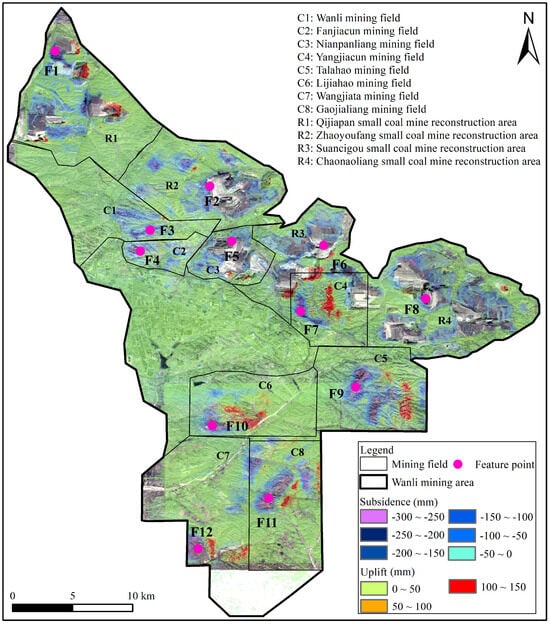
Figure 7.
Distributional location of twelve feature points.
Subsequently, we plotted the time series of cumulative subsidence for each feature point over the entire monitoring period (Figure 8). Notably, surface subsidence is first observed in the curve of feature point F1, located in northern zone R1, while it appears latest in the curve of feature point F11, situated in southern zone C8. Moreover, the curves clearly highlight multiple subsidence events that occurred during the monitoring period. For instance, the curve of feature point F11 shows three significant subsidence events in April 2020, April 2021, and May 2022. These events correspond to the initiation of coal excavation at three mining working faces within this panel, progressing from distant to near relative to the location of feature point F11.
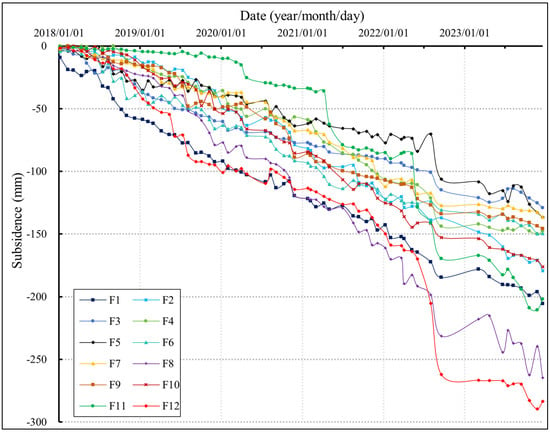
Figure 8.
Cumulative subsidence time series curves of feature points in the Wanli mining area.
4.4. Validation of SBAS-InSAR Monitoring Results
To verify the monitoring results of surface subsidence obtained through the SBAS-InSAR technique, we conducted a field investigation in the Gaojialiang mining field, focusing on mining-induced surface subsidence. The field investigation revealed that the primary geological disasters in the Gaojialiang mining field are ground fractures, which are represented by bright purple lines in Figure 9a. Statistical analysis of these identified ground fractures (Table 5) shows that there are 29 ground fractures located in the three panels of the Gaojialiang mining field; specifically, five ground fractures are distributed in panel 301, 12 ground fractures are distributed in panel 401, and 12 ground fractures are distributed in panel 203. Furthermore, the orientation of the majority of the fractures aligns with the tangential orientation of the subsidence margins in which they occur.
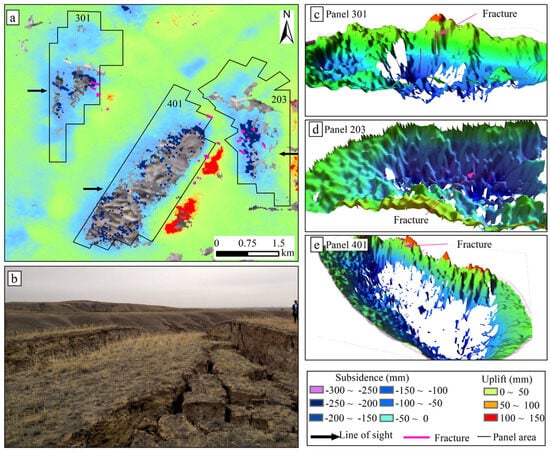
Figure 9.
Results of field validation. (a) Locations of ground fractures in the Gaojialiang mining field; (b) field observations of typical ground fractures; (c–e) are three-dimensional models of subsidence and ground fractures for panel 301, panel 203, and panel 401.

Table 5.
Specific structural conditions of 29 ground fractures.
Figure 9b shows a typical ground fracture, captured directly above by an unmanned aerial vehicle (UAV). To provide a more intuitive understanding of the distribution of these 29 ground fractures across the three panels, we created three-dimensional models of cumulative subsidence and fracture locations, illustrated in Figure 9c–e. The results indicate that the subsidence areas closely align with the boundaries of goafs in the Gaojialiang mining field, where the ground fractures are concentrated.
5. Discussion
Compared with traditional monitoring methods, the overall situation related to large-scale surface subsidence in the Wanli mining area monitored by the SBAS-InSAR technique is presented more intuitively and more completely in the results. We can clearly divide the 12 zones into underground coal mines (C1, C2, C4, C5, C6, C7, C8) and open-pit coal mines (R1, R2, R3, R4, C3). Due to diverse approaches with respect to exploration of coal resources, the subsidence characteristics of the two kinds of coal mines are quite different. The area of subsidence in open-pit coal mines is much larger than the area of subsidence in underground coal mines because the step-like slopes in the large occupied area are needed in open-pit coal mines for transport, while they are not required in underground coal mines [41,42]. Furthermore, considering the mines in terms of high yields and high efficiency, coal resources are excavated from smaller areas of underground coal mines [43], which leads to the steep boundaries of subsidence funnels, further inducing the appearance of ground fractures. Therefore, it is in the boundaries of subsidence funnels that geological disasters are prone to occur. If not monitored and controlled over time, these boundaries are likely to cause the expansion of ground fractures, and even collapses.
However, the central area of each mining subsidence zone has experienced severe short-term subsidence, resulting in decorrelation in the SBAS-InSAR monitoring results. More decoherence areas emerge in open-pit coal mines than in underground coal mines because of the extent of severe deformation over a short time interval induced by open-pit mining [44,45,46,47]. Conversely, situations relating to mining-induced subsidence have been monitored more completely in underground coal mines because of the hysteretic nature of subsidence caused by the action of gravity on the roof of the goaf. While SBAS-InSAR technology is less effective with respect to monitoring of intense subsidence in central subsidence zones [48,49,50], it exhibits high sensitivity to minor deformations along the edges of subsidence areas, with demonstrated reliability. Consequently, the findings of this study that employed SBAS-InSAR to analyze spatial distribution and subsidence trends in mining-affected regions are robust [51,52,53,54]. These results not only enable mining operators to pinpoint subsidence zones accurately and efficiently but also clearly demonstrate the characteristics and patterns of surface subsidence induced by coal mining in the geological context of the erosional landforms of the Loess Plateau. Furthermore, such data support targeted remediation in high-risk areas while optimizing monitoring expenditures. Collectively, this evidence underscores the strong suitability of SBAS-InSAR technology for erosional landform studies in the Loess Plateau.
In future research on mining-induced surface subsidence, relying exclusively on advanced InSAR technology to quantify subsidence in areas of severe subsidence presents significant challenges. However, combining InSAR technology with traditional monitoring methods (e.g., UAV remote sensing) will not only pinpoint subsidence zones with high precision and low cost but also enable targeted monitoring of critical areas [55,56,57,58]. This methodology ensures accurate deformation measurements that meet the operational demands of mining sites.
6. Conclusions
In this study, based on 64 Sentinel-1A SAR images, we conducted surface deformation monitoring of the Wanli mining area from 2018 to 2023 using the SBAS-InSAR technique. Key results include deformation velocity, relative subsidence, and time series of surface deformation. Significant findings are as follows:
- (1)
- The total area of subsidence during the monitoring period is 109.73 km2. Within these subsidence areas, the maximum cumulative subsidence is −283.41 mm, with the maximum surface subsidence velocity reaching −46.45 mm/y. Zone C7 is identified as the most severely affected area, with an average subsidence velocity of −11.08 mm/yr.
- (2)
- Twenty-nine ground fractures were identified, and they were concentrated along the borders of the monitored subsidence areas, where the surface slope is relatively steeper. Statistical analysis further revealed that the orientation of most ground fractures aligns with the tangential trend of the subsidence basin margin where they occur. These findings support the reliability of the SBAS-InSAR monitoring results. Moreover, the successful outcomes of this application can serve as a valuable reference for similar mining areas with complex topography.
- (3)
- The SBAS-InSAR monitoring results, including the distribution of subsidence zones, spatiotemporal evolution patterns, and subsidence trends, provide robust data to support policymaking for subsequent geological hazard mitigation and ecological conservation efforts in mining areas. Meanwhile, this study serves as a valuable reference for investigating surface subsidence patterns induced by coal mining across diverse geological conditions. However, due to inherent systematic errors and decorrelation effects, accurately quantifying subsidence rates in the central subsidence zones remains challenging, with potential measurement uncertainties. To address this limitation, future studies should combine traditional subsidence monitoring methods to implement targeted, high-precision observations in critical areas. This combined approach will not only ensure the acquisition of high-accuracy data meeting project requirements but also optimize cost efficiency in monitoring operations.
Author Contributions
The original Draft was written by X.X., who also performed the methodology and formal analysis. The conceptualization of this study was conducted by J.J., who also reviewed and edited the manuscript. G.L. and H.L. performed the data curation. Validation and visualization were performed by Q.C. and K.W. All authors have read and agreed to the published version of the manuscript.
Funding
This work was funded by the Natural Science Foundation of Inner Mongolia Autonomous Region (Grant No. 2024MS04025), the Fundamental Research Funds for the Central Universities in Inner Mongolia (Grant No. ZTY2024078), the National Natural Science Foundation of China (Grant No. 52264009), and the Doctoral Research Foundation of Inner Mongolia University of Technology (Grant No. BS2020024).
Data Availability Statement
The data that support the findings of this study are openly available and found in the ASF and GEE.
Acknowledgments
The authors greatly appreciated the following data supports: The DEM data were supported by the EARTHDATA network station (http://search.asf.alaska.edu, accessed on 15 August 2024). The Landsat data can be downloaded from the GEE (https://developers.google.com/earth-engine/datasets/catalog/landsat, accessed on 20 August 2024). The Sentinel-1A data and POD data were collected from the ASF (https://search.asf.alaska.edu, accessed on 21 August 2024).
Conflicts of Interest
The authors declare no conflicts of interest.
References
- Wang, S.; Liu, L.; Zhu, M. New way for green and low-carbon development of coal industry under the target of “daul-carbon”. J. China Coal Soc. 2024, 49, 152–171. [Google Scholar] [CrossRef]
- Soni, R.; Alam, S.M.; Vishwakarma, K.G. Prediction of InSAR deformation time-series using improved LSTM deep learning model. Sci. Rep. 2025, 15, 5333. [Google Scholar] [CrossRef]
- Hao, Q.; Zheng, Q.; Liu, S.; Hao, W.; Wu, X. Study on the Influence of Grouting Treatment on the Movement and Deformation of Surface in Longwall Coal Mining Goaf Areas. Mining Metall. Explor. 2024, 41, 1835–1858. [Google Scholar] [CrossRef]
- Bell, F.G.; Stacey, T.R.; Genske, D.D. Mining subsidence and its effect on the environment: Some differing examples. Environ. Geol. 2000, 40, 135–152. [Google Scholar] [CrossRef]
- Marín, M.R.; Sillerico, E.; Ezquerro, P.; Marchamalo, M.; Herrera, G.; Duro, J. Monitoring ground subsidence in urban environments: M-30 tunnels under Madrid City (Spain). Ing. Investig. 2015, 35, 30–35. [Google Scholar] [CrossRef]
- Cheng, J.; Wang, Z.; Li, S. Subsurface strata failure and movement based for improving gas emission control: Model development and application. Energy Sci. Eng. 2020, 8, 3285–3302. [Google Scholar] [CrossRef]
- Hrysiewicz, A.; Williamson, J.; Evans, D.C. Estimation and validation of InSAR-derived surface displacements at temperate raised peatlands. Remote Sens. Environ. 2024, 311, 114232. [Google Scholar] [CrossRef]
- Guillaume, M.; Cécile, D.; Frédéric, M. Time evolution of mining-related residual subsidence monitored over a 24-year period using InSAR in southern Alsace, France. Int. J. Appl. Earth Obs. Geoinf. 2021, 102, 102392. [Google Scholar] [CrossRef]
- Luo, P.; Jin, X.; Nie, D.; Liu, Y.; Wei, Y. Deformation Monitoring Based on SBAS-InSAR and Leveling Measurement: A Case Study of the Jing-Mi Diversion Canal in China. Sensors 2024, 24, 3871. [Google Scholar] [CrossRef]
- Li, Y.; Yang, K.; Yao, S.; Li, T. A DTSD model based on PS-InSAR surface multi-type deformation monitoring of villages in the mining area. Adv. Space Res. 2024, 74, 2042–2061. [Google Scholar] [CrossRef]
- Hu, L.; Tang, X.; Tomás, R.; Li, T.; Zhang, X.; Li, Z.; Yao, J.; Lu, J. Monitoring surface deformation dynamics in the mining subsidence area using LT-1 InSAR interferometry: A case study of Datong, China. Int. J. Appl. Earth Obs. Geoinf. 2024, 131, 103936. [Google Scholar] [CrossRef]
- Wempen, M.J.; McCarter, K.M. Comparison of L-band and X-band differential interferometric synthetic aperture radar for mine subsidence monitoring in central Utah. Int. J. Min. Sci. Technol. 2017, 27, 159–163. [Google Scholar] [CrossRef]
- Zhang, K.; Wang, Y.; Du, S.; Zhao, F.; Wang, T.; Zhang, N.; Zhou, D.; Diao, X. A Goaf-Locating Method Based on the D-InSAR Technique and Stratified Okada Dislocation Model. Remote Sens. 2024, 16, 2741. [Google Scholar] [CrossRef]
- Babaee, S.; Khalili, M.A.; Chirico, R.; Sorrentino, A.; Martire, D. Spatiotemporal characterization of the subsidence and change detection in Tehran plain (Iran) using InSAR observations and Landsat 8 satellite imagery. Remote Sens. Appl. Soc. Environ. 2024, 36, 101290. [Google Scholar] [CrossRef]
- Chen, Y.; Guo, L.; Xu, J.; Yang, Q.; Wang, H.; Zhu, C. Monitoring and Cause Analysis of surface subsidence along the Yangtze River Utilizing Time-Series InSAR. ISPRS Int. J. Geo-Inf. 2024, 13, 230. [Google Scholar] [CrossRef]
- Motagh, M.; Shamshiri, R.; Haghighi, H.M.; Wetzel, H.; Akbari, B.; Nahavandchi, H.; Roessner, S.; Arabi, S. Quantifying groundwater exploitation induced subsidence in the Rafsanjan plain, southeastern Iran, using InSAR time-series and in situ measurements. Eng. Geol. 2017, 218, 134–151. [Google Scholar] [CrossRef]
- Alam, M.S.; Kumar, D.; Chatterjee, R.S. Improving the capability of integrated DInSAR and PSI approach for better detection, monitoring, and analysis of land surface deformation in underground mining environment. Geocarto Int. 2022, 37, 3607–3641. [Google Scholar] [CrossRef]
- Colesanti, C.; Mouelic, L.S.; Bennani, M.; Raucoules, D.; Carnec, C.; Ferretti, A. Detection of mining related ground instabilities using the Permanent Scatterers technique—A case study in the east of France. Int. J. Remote Sens. 2007, 26, 201–207. [Google Scholar] [CrossRef]
- Frattini, P.; Crosta, B.G.; Rossini, M.; Allievi, J. Activity and kinematic behaviour of deep-seated landslides from PS-InSAR displacement rate measurements. Landslides 2018, 15, 1053–1070. [Google Scholar] [CrossRef]
- Shanker, P.; Casu, F.; Zebker, H.A.; Lanari, R. Comparison of Persistent Scatterers and Small Baseline Time-Series InSAR Results: A Case Study of the San Francisco Bay Area. IEEE Geosci. Remote Sens. Lett. 2011, 8, 592–596. [Google Scholar] [CrossRef]
- Berardino, P.; Fornaro, G.; Lanari, R.; Sansosti, E. A new algorithm for surface deformation monitoring based on small baseline differential SAR interferograms. IEEE Trans. Geosci. Remote Sens. 2002, 40, 2375–2383. [Google Scholar] [CrossRef]
- Hu, J.; Yan, Y.; Dai, H.; He, X.; Lv, B.; Han, M.; Zhu, Y.; Zhang, Y. Prediction Method for Dynamic Subsidence Basin in Mining Area Based on SBAS-InSAR and Time Function. Remote Sens. 2024, 16, 1938. [Google Scholar] [CrossRef]
- Ma, Z.; Yang, X.; Xie, L.; Dong, W. Life Cycle Mining Deformation Monitoring and Analysis Using Sentinel-1 and Radarsat-2 InSAR Time Series. Remote Sens. 2024, 16, 2335. [Google Scholar] [CrossRef]
- Dai, M.; Li, H.; Long, B.; Wang, X. Quantitative identification of landslide hazard in mountainous open-pit mining areas combined with ascending and descending orbit InSAR technology. Landslides, 2024, in press. [CrossRef]
- Ding, C.; Feng, G.; Zhang, L.; Wang, W. Retrospect on the Ground Deformation Process and Potential Triggering Mechanism of the Traditional Steel Production Base in Laiwu with ALOS PALSAR and Sentinel-1 SAR Sensors. Sensors 2024, 24, 4872. [Google Scholar] [CrossRef]
- Zhang, J.; Kou, P.; Tao, Y.; Jin, Z.; Huang, Y.; Cui, J.; Liang, W.; Liu, R. Urban ground subsidence monitoring and prediction using time-series InSAR and machine learning approaches: A case study of Tianjin, China. Environ. Earth Sci. 2024, 83, 473. [Google Scholar] [CrossRef]
- Xu, J.; Yan, C.; Boota, M.; Chen, X.; Li, Z.; Liu, W.; Yan, X. Research on automatic identification of coal mining subsidence area based on InSAR and time series classification. J. Clean. Prod. 2024, 470, 143293. [Google Scholar] [CrossRef]
- Wang, R.; Huang, S.; He, Y.; Wu, K.; Gu, Y.; He, Q.; Yan, H.; Yang, J. Construction of High-Precision and Complete Images of a Subsidence Basin in Sand Dune Mining Areas by InSAR-UAV-LiDAR Heterogeneous Data Integration. Remote Sens. 2024, 16, 2752. [Google Scholar] [CrossRef]
- Chang, K.; Zhao, Z.; Zhou, D.; Tian, Z.; Wang, C. Prediction of Surface Subsidence in Mining Areas Based on Ascending-Descending Orbits Small Baseline Subset InSAR and Neural Network Optimization Models. Sensors 2024, 24, 4770. [Google Scholar] [CrossRef]
- Yuan, M.; Li, M.; Liu, H.; Lv, P.; Li, B.; Zheng, W. Subsidence Monitoring Base on SBAS-InSAR and Slope Stability Analysis Method for Damage Analysis in Mountainous Mining Subsidence Regions. Remote Sens. 2021, 13, 3107. [Google Scholar] [CrossRef]
- Wang, Y.; Cui, X.; Ge, C.; Che, Y.; Zhao, Y.; Li, P.; Jiang, Y.; Han, X. Monitoring nonlinear large gradient subsidence in mining areas through SBAS-InSAR with PUNet and Weibull model fusion. Environ. Sci. Pollut. Res. Int. 2024, 31, 52815–52826. [Google Scholar] [CrossRef] [PubMed]
- Tang, W.; Ng, A.H.; Wang, H.; Kuang, J.; Du, Z. Surface Subsidence Characteristics and Causes Analysis in Ningbo Plain by Sentinel-1A TS-InSAR. Remote Sens. 2024, 16, 2438. [Google Scholar] [CrossRef]
- Wang, J.; Wang, F.; Chen, F.; Lu, S.; Li, Y.; Chen, M.; Wang, Y.; Li, C.; Zhang, Y.; Li, W. Dynamic fractionation of methane carbon isotope during mass transport in coal with bidisperse pore structures: Experiments, numerical modeling, and applications. Chem. Eng. J. 2024, 498, 154942. [Google Scholar] [CrossRef]
- Xie, Y.; Bagan, H.; Tan, L.; Te, T.; Damdinsuren, A.; Wang, Q. Time-Series Analysis of Mining-Induced Subsidence in the Arid Region of Mongolia Based on SBAS-InSAR. Remote Sens. 2024, 16, 2166. [Google Scholar] [CrossRef]
- Kalavrezou, I.; Melgar, I.; Nika, D.; Gatsios, T.; Lalechos, S.; Parcharidis, I. Application of Time Series INSAR (SBAS) Method Using Sentinel-1 for Monitoring Ground Deformation of the Aegina Island (Western Edge of Hellenic Volcanic Arc). Land 2024, 13, 485. [Google Scholar] [CrossRef]
- Huang, G.; Dong, J.; Xi, W.; Zhao, Z.; Li, S.; Kuang, Z.; An, Q.; Wei, J.; Zhu, Y. Study on surface deformation pattern in mine closure area of complex karst mountainous region based on SBAS-InSAR technology. Front. Earth Sci. 2024, 11, 1353593. [Google Scholar] [CrossRef]
- Wang, S.; Sun, H.; Wei, L.; Pi, P.; Zeng, M.; Pan, Y.; Xue, Z.; Jiang, X. Integrated Assessment of Coastal Subsidence in Nansha District, Guangzhou City, China: Insights from SBAS-InSAR Monitoring and Risk Evaluation. Remote Sens. 2024, 16, 248. [Google Scholar] [CrossRef]
- Agus, U.; Ram, A.; Wirastuti, W.; Alan, J.; Ali, P.Y.; Mohamed, K.K.; Gulab, S. Use of multifrequency (C-band and L-band) SAR data to monitor peat subsidence based on time-series SBAS InSAR technique. Land Degrad. Dev. 2021, 32, 4779. [Google Scholar] [CrossRef]
- Wang, R.; Feng, Y.; Tong, X.; Li, P.; Wang, J.; Tang, P.; Tang, X.; Xi, M.; Zhou, Y. Large-Scale Surface Deformation Monitoring Using SBAS-InSAR and Intelligent Prediction in Typical Cities of Yangtze River Delta. Remote Sens. 2023, 15, 4942. [Google Scholar] [CrossRef]
- Guo, H.; Yuan, Y.; Wang, J.; Cui, J.; Zhang, D.; Zhang, R.; Cao, Q.; Li, J.; Dai, W.; Bao, H.; et al. Large-Scale surface subsidence Monitoring and Prediction Based on SBAS-InSAR Technology with Time-Series Sentinel-1A Satellite Data. Remote Sens. 2023, 15, 2843. [Google Scholar] [CrossRef]
- Wang, S.; Cao, B.; Bai, R.; Liu, G. Dynamic optimization design of open-pit mine full-boundary slope considering uncertainty of rock mass strength. Sci. Rep. 2024, 14, 19710. [Google Scholar] [CrossRef] [PubMed]
- Han, T.; Li, Q.; Hai, Y.; Yang, Y.; Wen, Z.; Li, R.; Zheng, H. Response of ecosystem services and environmental dynamics in large open-pit coal mines: A case study in semi-arid areas. Glob. Ecol. Conserv. 2024, 51, e02891. [Google Scholar] [CrossRef]
- Ren, J.; Zhang, X.; Gu, Q.; Zhang, W.; Wang, W.; Fan, L. The Frequency Characteristics of Vibration Events in an Underground Coal Mine and Their Implications on Rock Burst Monitoring and Prevention. Sustainability 2024, 16, 5485. [Google Scholar] [CrossRef]
- Ng, M.H.A.; Wen, B.; Ma, Y.; Guo, L.; Dai, Y.; Wang, H.; Ge, L.; Du, Z. Integrating spatial modeling-assisted InSAR phase unwrapping with temporal analysis for advanced mine subsidence time series mapping. Int. J. Appl. Earth Obs. Geoinf. 2024, 133, 104143. [Google Scholar] [CrossRef]
- Pawluszek-Filipiak, K.; Borkowski, A. Integration of DInSAR and SBAS Techniques to Determine Mining-Related Deformations Using Sentinel-1 Data: The Case Study of Rydułtowy Mine in Poland. Remote Sens. 2020, 12, 242. [Google Scholar] [CrossRef]
- Karami, E.; Alizadeh, N.; Farhadi, H.; Abdolazimi, H.; Maghsoudi, Y. Monitoring of land surface displacement based on SBAS-InSAR time-series and GIS techniques: A case study over the Shiraz Merropolis, Iran. ISPRS Ann. Photogramm. Remote Sens. Spatial Inf. Sci. 2023, 10, 371–378. [Google Scholar] [CrossRef]
- Gyawu, A.; Baker, A.D.; Offei, A.K. An Assessment of Interventions to Improve Underground Coal Miners’ Ability to Self-Escape Using Human-Centered Design Methods. Mining Metall. Explor. 2024, 41, 2231–2243. [Google Scholar] [CrossRef]
- Sarychikhina, O.; Glowacka, E.; Ortega, G.A.J.; Meza, G.F.I. Three decades of subsidence monitoring in the Cerro Prieto basin, Mexicali Valley, using multi-temporal InSAR techniques. J. S. Am. Earth Sci. 2025, 156, 105375. [Google Scholar] [CrossRef]
- Woo, K.; Eberhardt, E.; Rabus, B.; Stead, D.; Vyazmensky, A. Integration of field characterisation, mine production and InSAR monitoring data to constrain and calibrate 3-D numerical modelling of block caving-induced subsidence. Int. J. Rock Mech. Min. Sci. 2012, 53, 166–178. [Google Scholar] [CrossRef]
- Anzidei, M.; Tolomei, C.; Trippanera, D.; Alberti, T.; Bosman, A.; Brunori, A.C.; Serpelloni, E.; Vecchio, A.; Falciano, A.; Deli, G. Multi-Temporal Relative Sea Level Rise Scenarios up to 2150 for the Venice Lagoon (Italy). Remote Sens. 2025, 17, 820. [Google Scholar] [CrossRef]
- Zheng, X.; Wang, C.; Tang, Y.; Zhang, H.; Li, T.; Zou, L.; Guan, S. Adaptive High Coherence Temporal Subsets SBAS-InSAR in Tropical Peatlands Degradation Monitoring. Remote Sens. 2023, 15, 4461. [Google Scholar] [CrossRef]
- Kou, P.; Xu, Q.; Jin, Z.; Tao, Y.; Yunus, A.; Feng, J.; Pu, C.; Yuan, S.; Xia, Y. Analyzing gully erosion and deposition patterns in loess tableland: Insights from small baseline subset interferometric synthetic aperture radar (SBAS InSAR). Sci. Total Environ. 2024, 916, 169873. [Google Scholar] [CrossRef]
- Duan, M.; Li, Z.; Xu, B.; Jiang, W.; Cao, Y.; Xiong, Y.; Wei, J. Turbulent atmospheric phase correction for SBAS-InSAR. J. Geod. 2024, 98, 81. [Google Scholar] [CrossRef]
- Bo, S.; Qun, D.; Wu, X. Estimation method of SBAS dual-frequency range error integrity parameter. Satell. Navig. 2020, 1, 663–673. [Google Scholar] [CrossRef]
- Cécile, D.; Aline, D.; Frédéric, M.; Anne, S.; Elias, L.; Raphaël, G.; Alexandre, N.; Patrice, U.; Jean-Bernard, C.D.; Ibrahim, S.; et al. Current deformation in Central Afar and triple junction kinematics deduced from GPS and InSAR measurements. Geophys. J. Int. 2017, 208, 936–953. [Google Scholar] [CrossRef]
- Ma, X.; Su, M.; Xue, Y.; Wang, P.; Qiu, D.; Han, M.; Ju, Z.; Liao, Z. Comprehensive Geophysical Evaluation of Grouting in the Goaf of an Urban Underground Coal Mine. Mine Water Environ. 2023, 42, 513–526. [Google Scholar] [CrossRef]
- Lee, J.C.; Shirzaei, M. Novel algorithms for pair and pixel selection and atmospheric error correction in multitemporal InSAR. Remote Sens. Environ. 2023, 286, 113447. [Google Scholar] [CrossRef]
- Guillaume, M.; Frédéric, M.; Cécile, D.; François, C. Repeated lidar acquisitions in an underground salt gallery in the Alsatian potassic basin (France): Monitoring and geomechanical modelling. Tunn. Undergr. Space Technol. 2022, 123, 104406. [Google Scholar] [CrossRef]
Disclaimer/Publisher’s Note: The statements, opinions and data contained in all publications are solely those of the individual author(s) and contributor(s) and not of MDPI and/or the editor(s). MDPI and/or the editor(s) disclaim responsibility for any injury to people or property resulting from any ideas, methods, instructions or products referred to in the content. |
© 2025 by the authors. Licensee MDPI, Basel, Switzerland. This article is an open access article distributed under the terms and conditions of the Creative Commons Attribution (CC BY) license (https://creativecommons.org/licenses/by/4.0/).